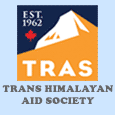

A Life with Slate
(2006, 59 min.)
Director: Dipesh Kharel
In Alampu, a beautiful and exceedingly remote village
in rural Nepal, more than 90% of villagers work in the local slate
mine. Their lives take on an almost poetic dimension, as women perform
treacherous and arduous work alongside men in the mountainside mines.
We learn how to separate slate slabs from the precipitous rock face and
watch as miners carry heavy slate loads to distant markets. The film
emphasizes the way co-operation between the miners makes this tough life
bearable, and portrays moving scenes of the lives of mining families.
Selected for the Nepal International Indigenous Film Festival 2007 and the Kathmandu International Mountain Film Festival 2007
back to top
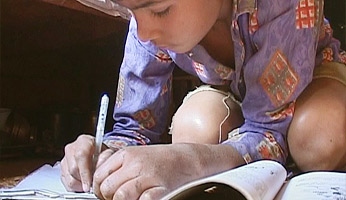
Yearning for Learning
(2006, 22 min.)
Director: Kedar Sharma
Twelve-year-old Bharat understands the challenge of
being born into a poor family in a poor country. For many children in
rural Nepal, attending school is a privilege rather than a right. Those
who don't go to school have futures shrouded in uncertainty. Bharat,
however, knows the importance of education. Through his and his
mother's undaunting efforts, he manages to go to school and reserve
some hours of the day for study. As well as telling Bharat's story, the
film discusses issues of child exploitation and abuse of children's
rights in Nepal.
Selected for the Jiri Film Festival, Nepal, March 2007
back to top
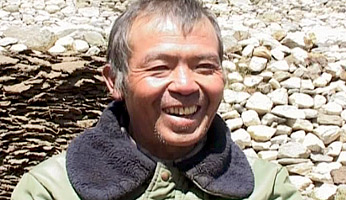 The Icefall Doctor: Angnima Sherpa
The Icefall Doctor: Angnima Sherpa
(2007, 28 min.)
Director: Hari Thapa
The Icefall Doctor examines the life and work of Angnima
Sherpa who, since 1975, has made the Khumbu Icefall safe for thousands
of climbers. The Khumbu Icefall is the terrifying gateway to Mt.
Everest from the south side. Angnima and his team are the first ones
too reach base camp, and the last ones to leave. Building anchors and
setting ladders, safety is their top priority. This fascinating,
beautiful film brings to light an aspect of climbing of which many
people are unaware.
Selected for the Kathmandu International Mountain Film Festival 2007
back to top
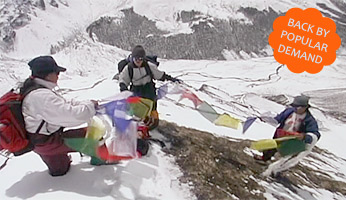
Daughters of Everest
(2004, 56 min.)
Directors: Sapana Sakya and Ramyata Limbu
The award winning and
captivating, Daughters of Everest documents
the first ever expedition of Sherpa women to climb Mt.
Everest. Although the
Sherpa people are legendary for their unmatched skill in
mountaineering, Sherpa women are discouraged from climbing Everest,
relegated instead
to support roles in the climbing industry of Nepal. Told
from a
woman's perspective rarely seen on Everest or off, this
film is both
a dramatic, inspiring Everest story and an absorbing
portrait of the
Sherpa community.
Awards
Best Documentary Award, Mt. Shasta Film Festival, California
Best Climbing Film, The Banff Mountain Film Festival, Canada
Jury Award, Mountain Film, Telluride, Colorado
Best Mountain Culture Documentary Award, Taos Mountain Film Festival, New Mexico
Grand Festival Award, Berkeley Video & Film Festival, California
Nominated for Best Documentary, Asian Film Festival in Dallas, Texas, 2004
back to top
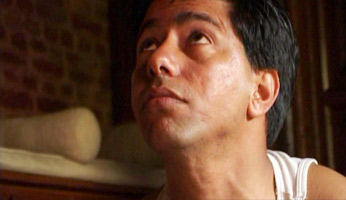 Machanaayo, the Leader Machanaayo, the Leader
(2006, 30 min.)
Director: Deepak Rauniyar
Troubled by the destruction of beautiful old houses in
Kathmandu, architect and sculptor, Rabindra Puri, quit his job to work
full-time preserving buildings built in traditional Nepali styles of
architecture. The film documents Rabindra's renovation and preservation
of Namuna Ghar, a stunning and intricately designed 150-year old
Newari-style house in Bhaktapur on the outskirts of Kathmandu. Rabindra
won the 2004 UNESCO Asia Pacific Heritage Award for his work. Namuna
Ghar has inspired more than 10,000 visitors, and stands as a model and
reminder of the importance of preserving Nepal's unique architectural
styles.
back to top
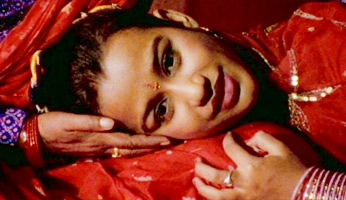 A Silent Monsoon A Silent Monsoon
(2007, 34 min.)
Director: Pravash Gurung
Set in a rural Nepali village,
Nabarasiyeko Jhari (A Silent Monsoon) tells the story of Durga and her
struggle to save her twelve-year-old daughter, Laxmi, from the family
profession of prostitution. Will Durga be able to fight society and her
fate, and set her daughter free? With brilliant performances by
Nepal's most respected actresses, Nisha Sharma Pokharel as Durga and
Subhadra Adhikari as her mother, the film questions "life" and "death"
through three generations of women trapped between custom and
circumstances, wrapped in the alluring beauty of Nepal.
www.praveshgurung.com
Official Selection at the following film festivals:
VC Filmfest: The Los Angeles Asian Pacific Film Festival, 2007
Aarhus Festival of Independent ArtsDenmark, 2007
Cleveland International Film Festival, 2007
Sarasota Film Festival, 2007
Sedona International Film Festival, 2007
back to top
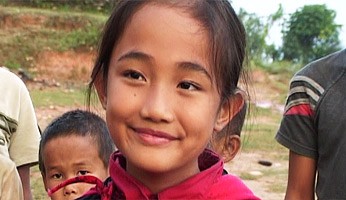 Kripa
Kripa
(2007, 80 min.)
Director: Maotse Gurung
During school vacation, an urban girl, Kripa, is
brought back to her natal village by her aunt to live with her deaf
father. Friendless and lonely, she meets a Lahure (a British/Indian
Gurkha), who teaches her to adjust to the village life. She finds
friendships in two village children, Neha and Thagu, and learns to feel
for her father, Ode, as well. It’s not long before Kripa finds herself
caring about a range of social issues.
Kripa, the film, is a beautiful presentation of
socio-cultural complexity involving the struggle of a reform-minded
individual against the forces who seek to sustain and benefit from
deep-rooted myths and superstition.
Selected for the Nepal International Indigenous Film
Festival 2007; Kathmandu International Mountain Film Festival 2007
Audience Award, Kathmandu International Mountain Film Festival 2007 (KIMFF 2007)
back to top
 December Blues
December Blues
(2006, 35 min.)
Director: Shekar Kharel
A look at modern day Kathmandu through the eyes of the
affluent youth. This intriguing documentary shows a side of Kathmandu
outside the typical scenes of mountain villages and their inhabitants.
It shows Nepal youth embracing dance clubs, party websites and western
style revelerie.
back to top
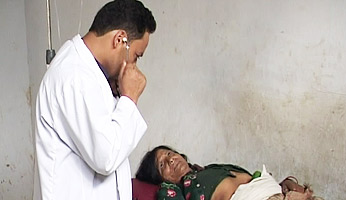 Outside the Newsroom
Outside the Newsroom
(2006, 23 min.)
Director: Dil Bhusan Pathak
After learning of the tragic death of a village woman
as a result of abortion by the most conservative and unhygienic means, a
television news anchor embarks on a journey to the remote Accham
district in pursuit of the story. Through the film, we learn about
archaic methods of abortion still prevalent in many parts of Nepal, and
the resulting suffering of women. The film captures the individual
tragedy that is the result of the vicious circle of poverty, ignorance,
gender discrimination and fatalism.
back to top
 A Nepali Émigré in Paris
A Nepali Émigré in Paris
(2006, 4 min.)
Director: Sushma Joshi
A Nepali man flees political repression in Nepal in the
late 1980s as the fight for democracy begins. After living in Paris for
20 years, he has had no reason to look back - until now, when both his
loyalty and his love are torn between two sides.
back to top
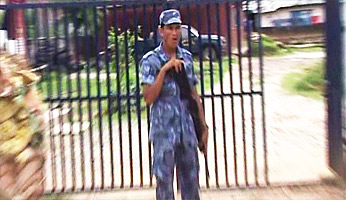 Better to have been Killed
Better to have been Killed
(2007, 52 min.)
Director: Dhruba Basnet
A beautifully shot film by a Nepali documentary supremo
that documents how journalists were treated during King Gyanendra's
reign.
back to top

Pani (Water)
(2000, 28 min.)
Director: Sushma Joshi
Pani documents the lively discussions between the
inhabitants of Lele, a rural Nepali village, about the daily problems
of their water supply system and its management. The film follows the
growing conflict in the community after the installation of a water
pipe and tap system. Gender and caste differences play a vital part in
the disputes as women and lower caste members are excluded from
decision making even though they are the principal users. The film
tracks the wide disparity in control and communication revealing
frustrations that result in the pipe being cut and maintenance fees
unpaid. The lesson portrayed is that even small scale models of
development will not work unless traditional social infrastructure,
especially gender biases and cultural discrimination, are addressed by
donors and local managers.
Selected for the Himalayan Film Festival, London, October 2007
back to top
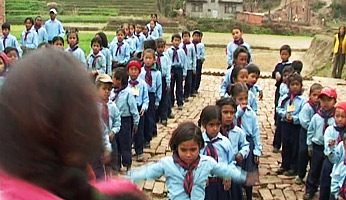 Our School
Our School
(2006, 28 min.)
Director: Kedar Sharma
Our School is a moving portrayal of “inclusive” schools
in Nepal and challenges discriminatory, exclusive practices against
disabled children. The narrator, Ramesh, himself a blind child,
explains how studying in a school with students who can see makes him
feel “normal”. The film focuses on three schools, taken as examples, in
different part of the country: the first is a school for deaf and
hearing-abled students; the second is for blind and sight-abled
students; and the third school, in the capital, teaches children of
brick-makers who come to Kathmandu for six months every year. The film
makes the points that these children are not disabled but rather are
different with their own unique abilities and talents, and should not
be excluded from attending school with other children.
back to top
|
|
Important Info:
Time: 11am-6:30pm
Date: February 24, 2008
Place: Langara College
(100 West 49th Avenue) |






 Machanaayo, the Leader
Machanaayo, the Leader 
 Kripa
Kripa 








